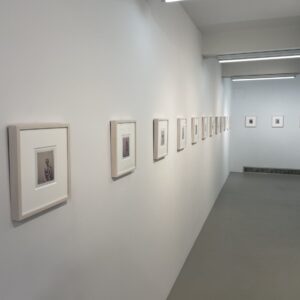JTF (just the facts): A total of 22 black and white photographs, framed in black and unmatted, and hung against white walls in the smaller downstairs gallery. All of the works are archival pigment prints, undated. 16 of the works (the portraits) are sized either 12×12 (in editions of 10) or 20×20 (in editions of 5). The remaining 6 works are sized 8×8. The project was supported by a grant from The Pulitzer Center on Crisis Reporting (here). A monograph of this body of work was published in 2016 by FotoEvidence (here). (Installation shots below.)
Comments/Context: The multiple exposure photograph hasn’t often been put to much productive use in the realm of photojournalism. Perhaps we assume there is something inherently “arty” about sandwiched imagery that seems to undermine the truth telling we are expecting. Or maybe such pictures feel manipulated in a way that is somehow at odds with our definitions of documentary straight shooting. But if the goal of the engaged photojournalist is first and foremost to be an effective visual storyteller, and to do so by whatever means best suited to the task, then maybe the multiple exposure deserves a second look, at least in the right circumstances.
If we think about the stories Daniella Zalcman set out to tell in her recent series Signs of Your Identity, the multiple exposure portrait is a near perfect vehicle for combining faces and places in resonant combinations. Her subjects are members of the Canadian indigenous population who were forced to attend Indian residential schools as children to “help” them to culturally assimilate. The individual details of their experiences as children are often harrowing – rape, physical abuse, assault, punishment, even chemical testing – and as adult survivors, they remain permanently scarred by these traumas. Not only was their native culture taken from them, what replaced it was little different than the harshness of jail. Many now suffer from persistent problems with alcohol, or continue to have trouble feeling comfortable in their own skin, the memories of those experiences still impacting their lives decades later.
Zalcman’s double exposures intermingle head shot portraits of the native peoples with images taken at the schools they attended. For the most part, these boarding schools are now gone, so the visual remain now range from rotting abandoned structures to open fields where there schools once stood. When combined with the present day portraits, the effect is nothing short of haunting. The faces dissolve into the very places that tormented them, becoming obscured by their lasting remnants.
The logic of this aesthetic combination is breathtakingly simple and yet eerily powerful. These people are literally being subsumed by the terrors of the past, both visually in Zalcman’s portraits and emotionally in their day to day lives. The ghost or spirit metaphor is particularly apt, as faces shimmer in and out of clarity, overcome by the filtered essence of walls, trees, clouds, and broken windows. And Zalcman is well attuned to the available textures, using the roughness of brick or crackled peeling paint to quietly interrupt the etched lines of a wearily troubled face. It’s as if these hated places are now indelibly part of the personalities of her sitters, a reality that makes Zalcman’s images that much more grimly discouraging.
Perhaps there is catharsis to be found in the telling of these terrible stories. But the nuance here lies in the ephemeral beauty of these pictures. They are graceful and attentive, sensitive to the tragedies that lie very near the surface, and yet constantly shifting, never entirely capturing the duality being composed. That uncertainty is what makes the images effective. Each face oscillates between past and present without an overly easy or neat solution. Zalcman has allowed us to see the lingering echoes of memory, without reducing the intensity of its invisible influence.
Collector’s POV: The works in this show are priced in rising editions as follows. The 12×12 portraits range between $1000 and $2000, while the 20×20 portraits range from $1700 to $3375. Zalcman’s work has little secondary market history, so gallery retail remains the best option for those collectors interested in following up.















